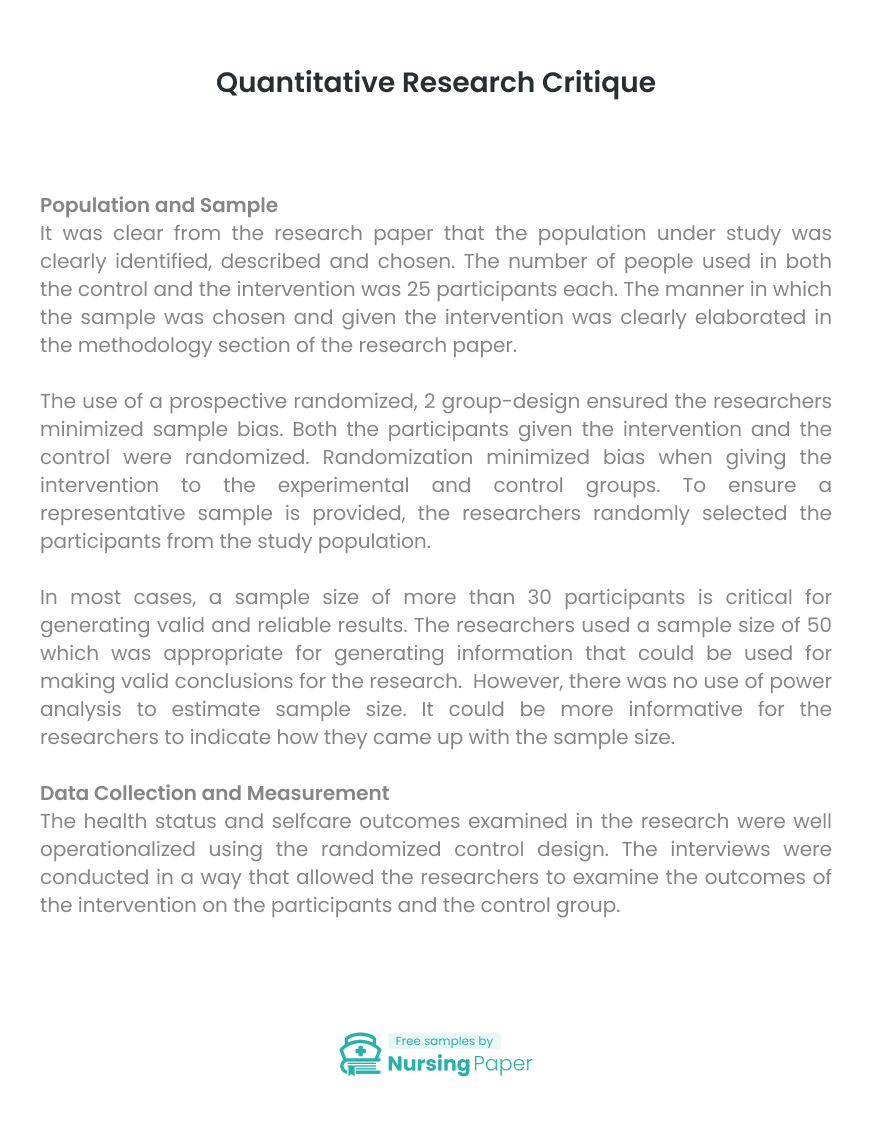
Quantitative Research Critique
Population and Sample
It was clear from the research paper that the population under study was clearly identified, described and chosen. The number of people used in both the control and the intervention was 25 participants each. The manner in which the sample was chosen and given the intervention was clearly elaborated in the methodology section of the research paper.
The use of a prospective randomized, 2 group-design ensured the researchers minimized sample bias. Both the participants given the intervention and the control were randomized. Randomization minimized bias when giving the intervention to the experimental and control groups. To ensure a representative sample is provided, the researchers randomly selected the participants from the study population.


In most cases, a sample size of more than 30 participants is critical for generating valid and reliable results. The researchers used a sample size of 50 which was appropriate for generating information that could be used for making valid conclusions for the research. However, there was no use of power analysis to estimate sample size. It could be more informative for the researchers to indicate how they came up with the sample size.
Data Collection and Measurement
The health status and selfcare outcomes examined in the research were well operationalized using the randomized control design. The interviews were conducted in a way that allowed the researchers to examine the outcomes of the intervention on the participants and the control group.
The research instruments used in the research were adequately described. The authors comprehensively explained each of the research questionnaires or research instruments used in the experiment. With the right type of instruments, it was easier for the researchers to collect the right type of information.

There was evidence that the researchers strived to maintain validity and reliability. During the study, two participants were lost. This has potential for compromising internal validity of the research. However, the participants that were lost were replaced and their data was eliminated from the data analysis. This was a step to regain the internal validity of the company. The research design, analysis and approach to research was conducted in way that ensured the results were reliable. This included the use of reliable data sources, data verification, randomization, and involvement of the participants in the research at the end of the study.
1. Clark, A. P., McDougall, G., Riegel, B., Joiner-Rogers, G., Innerarity, S., Meraviglia, M., … & Davila, A. (2015). Health status and self-care outcomes following an education-support intervention for people with chronic heart failure. The Journal of cardiovascular nursing, 30(4 0 1), S3.



The download will start shortly.

The download will start shortly.
 Subject:
Medicine
Subject:
Medicine  Number of pages: 3
Number of pages: 3  Subject:
Health and Social Care
Subject:
Health and Social Care  Number of pages: 299
Number of pages: 299  Subject:
Health and Social Care
Subject:
Health and Social Care  Number of pages: 4
Number of pages: 4  Subject:
Health and Social Care
Subject:
Health and Social Care  Number of pages: 5
Number of pages: 5  Subject:
Health and Social Care
Subject:
Health and Social Care  Number of pages: 4
Number of pages: 4  Subject:
Health and Social Care
Subject:
Health and Social Care  Number of pages: 4
Number of pages: 4  Subject:
Medicine
Subject:
Medicine  Number of pages: 18
Number of pages: 18  Subject:
Health and Social Care
Subject:
Health and Social Care  Number of pages: 2
Number of pages: 2  Subject:
Nursing
Subject:
Nursing  Number of pages: 2
Number of pages: 2  Subject:
Medicine
Subject:
Medicine  Number of pages: 3
Number of pages: 3  Subject:
Nursing
Subject:
Nursing  Number of pages: 4
Number of pages: 4  Subject:
Medicine
Subject:
Medicine  Number of pages: 4
Number of pages: 4  Subject:
Nursing
Subject:
Nursing  Number of pages: 4
Number of pages: 4  Subject:
Medicine
Subject:
Medicine  Number of pages: 17
Number of pages: 17  Subject:
Nursing
Subject:
Nursing  Number of pages: 3
Number of pages: 3 
